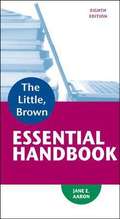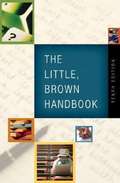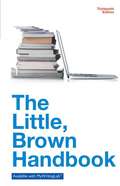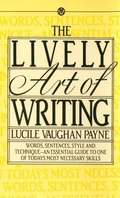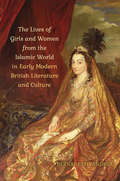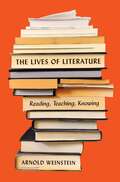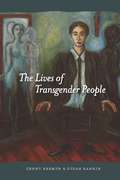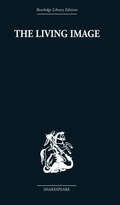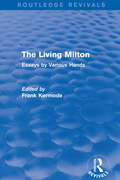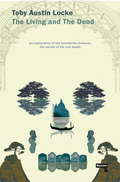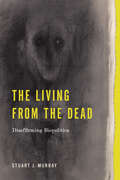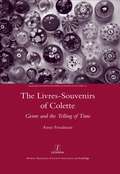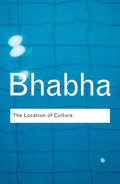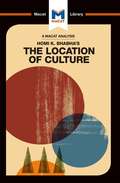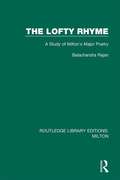- Table View
- List View
The Little, Brown Compact Handbook with Exercises (7th Edition)
by Jane E. AaronThe Little, Brown Compact Handbook with Exercises packages the authority and currency of its best-selling parent, The Little, Brown Handbook, in a briefer book with spiral binding, tabbed dividers, and more than 150 exercises. Concise and accessible, The Little, Brown Compact Handbook helps writing students find what they need and then use what they find. It provides clear explanations of the writing process, grammar, usage, critical thinking, and argument. Its thorough, up-to-date coverage of research writing stresses the library as Web gateway, evaluation and synthesis of print and online sources, and intellectual honesty. It provides the latest documentation guidelines in MLA, APA, Chicago, and CSE styles.
The Little, Brown Essential Handbook (Eighth Edition)
by Jane E. AaronFor first year composition and undergraduate courses across the curriculum. The Little, Brown Essential Handbook , Eighth Edition, is a brief, accessible, and inexpensive pocket-sized handbook that answers questions about writing in the disciplines, the writing process, grammar and usage, research writing, and documentation. Teaching and Learning Experience This text will provide a better teaching and learning experience--for you and your students. It provides: · Minimal terminology, clear explanations and examples, and pointers for ESL writers: Help students at all levels of learning. · Extensive sections on academic writing, research writing, source documentation, and document design: Support writers in all disciplines. · Convenient pocket size, four-color design, spiral binding, and numerous reference aids: Make the book convenient to carry and easy to use.
The Little, Brown Handbook (10th Edition)
by Jane E. Aaron H. Ramsey FowlerThe Little, Brown Handbook is a basic resource that will answer almost any question you have about writing. You can find how to get ideas, punctuate quotations, search the Internet, cite sources, or write a résumé. The handbook can help you not only in writing courses but also in other courses and outside school.
The Little, Brown Handbook (High School Version)
by Jane E. Aaron H. Ramsey FowlerThe handbook can help students build the writing skills they need to prepare for college-level coursework in many disciplines like developing paragraphs, punctuate quotations, write a college-application essay etc.
The Little, Brown Handbook (Thirteenth Edition)
by Jane E. Aaron H. Ramsey Fowler<P>The gold standard of handbooks – unmatched in accuracy, currency, and reliability. <P>The Little, Brown Handbook is an essential reference tool and classroom resource designed to help students find the answers they need quickly and easily.<P> While keeping pace with rapid changes in writing and its teaching, it offers the most comprehensive research and documentation available–with grammar coverage that is second to none.<P> With detailed discussions of critical reading, media literacy, academic writing, and argument, as well as writing as a process, writing in the disciplines, and writing beyond the classroom, this handbook addresses writers of varying experience and in varying fields.
The Little, Brown Handbook 12th Edition
by Jane E. Aaron H. Ramsey FowlerThe Little, Brown Handbook provides reliable and thorough coverage of handbook basics--the writing process, grammar and usage, research and documentation--while also giving detailed discussions of critical reading, academic writing, reading and writing arguments, writing in the disciplines, and public writing. Widely used by both experienced and inexperienced writers, The Little, Brown Handbook works as both a comprehensive classroom text and an accessible reference guide.
The Little, Brown Workbook (10th Edition)
by Donna GorrellThe tenth edition of The Little, Brown Workbook is designed to closely parallel its companion, The Little, Brown Handbook, Tenth Edition, in organization, approach and guidelines for writing. Instructors can use the workbook as an instructional supplement to the handbook or as an independent text. The format of the workbook allows instructors to use each part according to their own teaching styles and their students' needs, choosing to use parts sequentially or as reference guides.
The Lived Experience of Chinese International Students in the U.S.: An Academic Journey (Education in the Asia-Pacific Region: Issues, Concerns and Prospects #56)
by Yalun Zhou Michael WeiThis book marks a departure from traditional assumptions concerning the deficiencies of Chinese international students in terms of learning and adapting. It employs phenomenological narrative inquiry and a small culture approach to investigate the evolved, fluid experience of pursuing a graduate degree in the U.S. at Blue Fountain University (a pseudonym for a mid-western university).Adopting an interdisciplinary perspective, this book addresses two fundamental questions: What study abroad is and what study abroad counts? The sociocultural dimensions that shape the cross-border degree seeking endeavors inform stakeholders what works for Chinese international students’ successful pursuits as EFL learners and ESL users and what could be improved. This book shares thoughts on the implications and impact of educational contexts to stakeholders at normal and dynamic contexts interrupted by global pandemic outbreak. It contributes to the understanding of the internationalization of the host institute and the EFL education reform efforts (policy making, teacher education, and classroom practice) in China (and in Asia at large).
The Lively Art of Writing
by Lucile Vaughan PayneThis book helps students improve their writing style. It explains and demonstrates specific techniques and provides exercises that will help students master them. By the time they finish this book, they would have learned enough about style to improve their writing more than they ever believed possible.
The Lives of Frederick Douglass
by Robert S. LevineFrederick Douglass's changeable sense of his own life story is reflected in his many conflicting accounts of events during his journey from slavery to freedom. Robert S. Levine creates a fascinating collage of this elusive subject--revisionist biography at its best, offering new perspectives on Douglass the social reformer, orator, and writer.
The Lives of Girls and Women from the Islamic World in Early Modern British Literature and Culture
by Bernadette AndreaBernadette Andrea’s groundbreaking study recovers and reinterprets the lives of women from the Islamic world who travelled, with varying degrees of volition, as slaves, captives, or trailing wives to Scotland and England during the sixteenth and seventeenth centuries. Andrea’s thorough and insightful analysis of historical documents, visual records, and literary works focuses on five extraordinary women: Elen More and Lucy Negro, both from Islamic West Africa; Ipolita the Tartarian, a girl acquired from Islamic Central Asia; Teresa Sampsonia, a Circassian from the Safavid Empire; and Mariam Khanim, an Armenian from the Mughal Empire. By analysing these women’s lives and their impact on the literary and cultural life of proto-colonial England, Andrea reveals that they are simultaneously significant constituents of the emerging Anglo-centric discourse of empire and cultural agents in their own right. The Lives of Girls and Women from the Islamic World in Early Modern British Literature and Culture advances a methodology based on microhistory, cross-cultural feminist studies, and postcolonial approaches to the early modern period.
The Lives of Literature: Reading, Teaching, Knowing
by Arnold WeinsteinA passionate, wry, and personal book about how the greatest works of literature illuminate our livesWhy do we read literature? For Arnold Weinstein, the answer is clear: literature allows us to become someone else. Literature changes us by giving us intimate access to an astonishing variety of other lives, experiences, and places across the ages. Reflecting on a lifetime of reading, teaching, and writing, The Lives of Literature explores, with passion, humor, and whirring intellect, a professor’s life, the thrills and traps of teaching, and, most of all, the power of literature to lead us to a deeper understanding of ourselves and the worlds we inhabit.As an identical twin, Weinstein experienced early the dislocation of being mistaken for another person—and of feeling that he might be someone other than he had thought. In vivid readings elucidating the classics of authors ranging from Sophocles to James Joyce and Toni Morrison, he explores what we learn by identifying with their protagonists, including those who, undone by wreckage and loss, discover that all their beliefs are illusions. Weinstein masterfully argues that literature’s knowing differs entirely from what one ends up knowing when studying mathematics or physics or even history: by entering these characters’ lives, readers acquire a unique form of knowledge—and come to understand its cost.In The Lives of Literature, a master writer and teacher shares his love of the books that he has taught and been taught by, showing us that literature matters because we never stop discovering who we are.
The Lives of Transgender People
by Genny Beemyn Susan RankinResponding to a critical need for greater perspectives on transgender life in the United States, Genny Beemyn and Susan (Sue) Rankin apply their extensive expertise to a groundbreaking survey-one of the largest ever conducted in the U.S.-on gender development and identity-making among transsexual women, transsexual men, crossdressers, and genderqueer individuals. With nearly 3,500 participants, the survey is remarkably diverse, and with more than 400 follow-up interviews, the data offers limitless opportunities for research and interpretation.Beemyn and Rankin track the formation of gender identity across individuals and groups, beginning in childhood and marking the "touchstones" that led participants to identify as transgender. They explore when and how participants noted a feeling of difference because of their gender, the issues that caused them to feel uncertain about their gender identities, the factors that encouraged them to embrace a transgender identity, and the steps they have taken to meet other transgender individuals. Beemyn and Rankin's findings expose the kinds of discrimination and harassment experienced by participants in the U.S. and the psychological toll of living in secrecy and fear. They discover that despite increasing recognition by the public of transgender individuals and a growing rights movement, these populations continue to face bias, violence, and social and economic disenfranchisement. Grounded in empirical data yet rich with human testimony, The Lives of Transgender People adds uncommon depth to the literature on this subject and introduces fresh pathways for future research.
The Living Dead: A Study of the Vampire in Romantic Literature
by James B. TwitchellIn his Preface to The Living Dead: A Study of the Vampire in Romantic Literature, James Twitchell writes that he is not interested in the current generation of vampires, which he finds "rude, boring and hopelessly adolescent. However, they have not always been this way. In fact, a century ago they were often quite sophisticated, used by artists varied as Blake, Poe, Coleridge, the Brontes, Shelley, and Keats, to explain aspects of interpersonal relations. However vulgar the vampire has since become, it is important to remember that along with the Frankenstein monster, the vampire is one of the major mythic figures bequeathed to us by the English Romantics. Simply in terms of cultural influence and currency, the vampire is far more important than any other nineteenth-century archetypes; in fact, he is probably the most enduring and prolific mythic figure we have. This book traces the vampire out of folklore into serious art until he stabilizes early in this century into the character we all too easily recognize.
The Living Eye
by Arthur Goldhammer Jean StarobinskiThis volume is a translation of selections of L'Oeil vivant (1961 and 70). Harvard Studies in Comparative Literature
The Living Image: Shakespearean Essays
by T. R. HennFirst published in 1972. The imagery of field sports - of hawking, hunting, shooting and fishing - and the associated imagery of warfare are a striking feature in Shakespeare's plays. The Living Image examines the nature of this imagery, considering it first in the light of the practices and techniques of Elizabethan field sports and weaponry and then its broader metaphoric significance in relation to the themes of the plays. The contemporary associations of the imagery - the inferences of female sexuality and waywardness from hawking imagery, for example, and the ideals of nobility and courage attached to images of hunting and war are all discussed.
The Living Milton: Essays by Various Hands (Routledge Revivals)
by Sir Frank KermodeVarious aspects of Milton are explored in this collection of essays by scholars whose reputations were, at the time of publication in 1960, perhaps largely based on their writings on more modern subjects. This had the advantage of demonstrating that Milton as a poet is "alive" and that other attempts to represent him as irrelevant to the interests of the modern reader had failed. The essays offer to admirers of Milton and of modern poetry cogent and mature arguments for restoring a great poet to his proper authority in our literary life.
The Living Stream: Yeats Annual No. 18
by Warwick GouldYeats Annual No. 18 is another special issue in this renowned research-level series offering a tribute to the pioneering Yeats scholar, A. Norman Jeffares. <p><p> Memories of the man are shared by Seamus Heaney, Christopher Rush and Colin Smythe, who compiles a bibliography of Jeffares’s work. Terence Brown, Neil Corcoran, Warwick Gould, Joseph M. Hassett, Phillip L. Marcus, Ann Saddlemyer, Ronald Schuchard, Deirdre Toomey and Helen Vendler offer essays on such topics as Yeats and the Colours of Poetry, Yeats’s Shakespeare, Yeats and Seamus Heaney, Lacrimae Rerum and Tragic Joy, Raftery’s work on Yeats’s Thoor Ballylee, Edmund Dulac’s portrait of Mrs George Yeats, The Tower as an anti-Modernist monument, with close studies of ‘Vacillation’, ‘Her Triumph’, and ‘The Cold Heaven’. <p> Throughout, the essays are inflected with memories of Jeffares and his critical methods. The volume is rounded with further essays on A Vision by Neil Mann and Matthew de Forrest, while reviews of recent editions and studies are provided by Matthew Campbell, Wayne K. Chapman, Sandra Clark, Denis Donoghue, Nicholas Grene, Joseph M. Hassett, and K.P.S. Jochum.
The Living and the Dead
by Toby Austin LockeThe Living and the Dead examines the boundaries between the worlds of life and death. The text draws upon philosophy, ethnography, literature and natural science to suggest that life and death are best understood not in opposition, but as continuous tendencies acting upon one another. Austin Locke argues that the failure to give nuanced consideration to the connections between the living and nonliving devalues both life and death. In doing so, he suggests that our ability to respond to the challenges of environmental degradation, technological advancement, and the dominance of economic logic depend in part on more fluid understandings of the relationship between life and death.From the Trade Paperback edition.
The Living from the Dead: Disaffirming Biopolitics (RSA Series in Transdisciplinary Rhetoric)
by Stuart J. MurrayIn a society that aims above all to safeguard life, how might we reckon with ethical responsibility when we are complicit in sacrificial economies that produce and tolerate death as a necessity of life?Arguing that biopower can be fully exposed only through an analysis of those whom society has “let die,” Stuart J. Murray employs a series of transdisciplinary case studies to uncover the structural and rhetorical conditions through which biopower works. These case studies include the concept of “sacrifice” in the “war” against COVID-19, where emergent cultures of pandemic “resistance” are explored alongside suicide bombings and military suicides; the California mass hunger strikes of 2013; legal cases involving “preventable” and “untimely” childhood deaths, exposing the irreconcilable claims of anti-vaxxers and Indigenous peoples; and the videorecording of the death of a disabled Black man. Murray demonstrates that active resistance to biopower inevitably reproduces tropes of “making live” and “letting die.” His counter to this fact is a critical stance of disaffirmation, one in which death disrupts the politics of life itself.A philosophically nuanced critique of biopower, The Living from the Dead is a meditation on life, death, power, language, and control in the twenty-first century. It will appeal to students and scholars of rhetoric, philosophy, and critical theory.
The Livres-souvenirs of Colette: Genre and the Telling of Time
by Anne FreadmanThroughout her career, Colette experimented with genre for the purposes of telling stories of her life. The books that resulted, known collectively as her 'livres-souvenirs', are far from being autobiographies in the customary sense. By addressing the need to reconsider the generic issues surrounding autobiographical story-telling, Anne Freadman's study brings the richness of 'the genre question' to the fore, shedding a fresh light on this much-loved body of work. From the vignettes ofLa Maison de Claudineto the note-books ofL'etoile vesper andLe Fanal bleu, from stories of losing to stories of collecting, Colette's memory books take different narrative forms and explore the passing of time in different ways. This book investigates Colette's variegated generic choices as so many ways of 'telling time'.
The Location of Culture
by Homi K. BhabhaRethinking questions of identity, social agency and national affiliation, Bhabha provides a working, if controversial, theory of cultural hybridity - one that goes far beyond previous attempts by others. In The Location of Culture, he uses concepts such as mimicry, interstice, hybridity, and liminality to argue that cultural production is always most productive where it is most ambivalent. Speaking in a voice that combines intellectual ease with the belief that theory itself can contribute to practical political change, Bhabha has become one of the leading post-colonial theorists of this era.
The Location of Culture
by Stephen Fay Liam HaydonHomi K. Bhabha’s 1994 The Location of Culture is one of the founding texts of the branch of literary theory called postcolonialism. While postcolonialism has many strands, at its heart lies the question of interpreting and understanding encounters between the western colonial powers and the nations across the globe that they colonized. Colonization was not just an economic, military or political process, but one that radically affected culture and identity across the world. It is a field in which interpretation comes to the fore, and much of its force depends on addressing the complex legacy of colonial encounters by careful, sustained attention to the meaning of the traces that they left on colonized cultures. What Bhabha’s writing, like so much postcolonial thought, shows is that the arts of clarification and definition that underpin good interpretation are rarely the same as simplification. Indeed, good interpretative clarification is often about pointing out and dividing the different kinds of complexity at play in a single process or term. For Bhabha, the object is identity itself, as expressed in the ideas colonial powers had about themselves. In his interpretation, what at first seems to be the coherent set of ideas behind colonialism soon breaks down into a complex mass of shifting stances – yielding something much closer to postcolonial thought than a first glance at his sometimes dauntingly complex suggests.
The Location of Experience: Victorian Women Writers, the Novel, and the Feeling of Living (Lit Z)
by Adela PinchWe tend to feel that works of fiction give us special access to lived experience. But how do novels cultivate that feeling? Where exactly does experience reside? The Location of Experience argues that, paradoxically, novels create experience for us not by bringing reality up close, but by engineering environments in which we feel constrained from acting. By excavating the history of the rise of experience as an important category of Victorian intellectual life, this book reveals how experience was surprisingly tied to emotions of remorse and regret for some of the era’s great women novelists: the Brontës, George Eliot, Margaret Oliphant, and Elizabeth Gaskell. It shows how these writers passed ideas about experience—and experiences themselves—among each other.Drawing on intellectual history, psychology, and moral philosophy, The Location of Experience shows that, through manipulating the psychological dimensions of fiction’s formal features, Victorian women novelists produced a philosophical account of experience that rivaled and complemented that of the male philosophers of the period.The Location of Experience: Victorian Women Writers, the Novel, and the Feeling of Living is available from the Knowledge Unlatched on an open-access basis.
The Lofty Rhyme: A Study of Milton's Major Poetry (Routledge Library Editions: Milton #9)
by Balachandra RajanFirst published in 1970. Few books on Milton have dealt with his poetry as a whole. The present study, a discussion of Milton’s major poetry, seeks to examine each of the poems on its own distinctive grounds and also to delineate the pattern of continuity which the poems enter into and sustain. The author shows how each poem creates its own strategy of insight and demonstrates that together they explore and define a centre of recognition more fully than is possible with any single work. The book makes full use of the results of Milton scholarship and will provide a basis for a fresh appreciation of the complexity and unity of Milton’s achievement.

